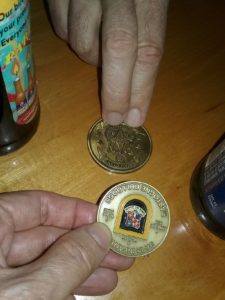
While my main goal is that my stories are entertaining, I also hope that a reader leaves the novel richer in some way, having learned something cool, or with a new way to think about things. One of the advantages of writing about military personnel for a writer who’s actually been in the military is that small, accurate details can help bring the story alive.
In both New Heights and the upcoming Submerged Hopes, there are instances of a “coin check” in a bar, in which the “value” of the proffered medallion determines who picks up the check. So today, let’s chat about Commander’s Coins, also called Challenge Coins.
As far back as during the Roman Empire, soldiers were rewarded with coins for a special achievement. In the time before special coins were minted, a soldier who’d conducted himself bravely in battle was given a coin to buy a drink by his superior. Sometimes, the coin was just handed over, but more often, it was a spectacle, with the coin slapped down loudly on the bar, to call attention to the soldier. Coins from a high-ranking officer were felt to be more valuable, and were often saved rather than being used for a drink, instead carried as a tangible reminder of glory.
During World War I, prior to the entry of the U.S. into the war, volunteers left college and jobs to form flying squadrons, including some aviators from wealthy families. In one such squadron, a wealthy lieutenant ordered bronze medallions for his unit as a gesture of solidarity. One pilot wore his in a leather pouch. When his aircraft was damaged by ground fire, his forced landing put him behind enemy lines, and he was captured by a German patrol, who confiscated his ID. He was able to escape during a bombardment that night, found some civilian clothes, and made it to a French outpost. However, the French assumed he was a saboteur and were going to execute him. Though he had no ID to prove he was American, he showed his medallion to them, and one recognized the unit insignia, and delayed his execution long enough to confirm his identity. Instead of a bullet, they gave him a bottle of wine.
His squadron saw the value of the medallions, and it became tradition to for members to challenge each other to produce the coin. If a member could not, they were required to buy the challenger a drink. If the service member came up with the medallion, the challenger had to buy the other guy a drink.
Challenge coins are still used today, both to foster unit morale, and to reward special achievements. The “rules” vary from branch to branch, and within units, but some general rules apply. The act of challenging is called a “Coin Check.” It often begins with the challenger drawing a coin and slapping it onto the bar, or rapping it loudly to call attention. Everyone challenged must produce their organizational coin or any special achievement coin they possess. Failing to do so means they must buy a round of drinks for the challenger and everyone who has their coin. If all of the challenged service members are able to show their coin, the challenger must buy for the group. If someone drops their coin in a hideous show of disrespect, they’d better be prepared to open their wallet for everyone there.
Most coin holders carry them in their pockets or billfolds, but a coin within “a step and a reach” is permitted, so someone with an extra coin might choose to pass one to a buddy. Coins on belt buckles or key chains don’t count, however. If one is so careless as to allow someone to steal a challenge coin, they must buy a round for the thief and the entire group. In addition, the holder of the highest-ranking coin gets a drink from everyone. Some people never have to buy again!
The “rank” of the coin is determined in part by the rank of the giver, e.g. a coin given by a Captain outranks one given by a Lieutenant, and an Admiral’s coin outranks both. A coin’s rank is also determined by the difficulty of the achievement for which the coin was given: a special achievement counts for more than a unit coin.
Coins given for merit are often handed out at the time by high-ranking officers, or the service member is called in later for recognition. In either case, the rewarding officer palms the coin, disguised as a handshake, and presses it between them. It’s a fun moment, to feel the hard, smooth edge, and wonder what it looks like.
Recent Comments